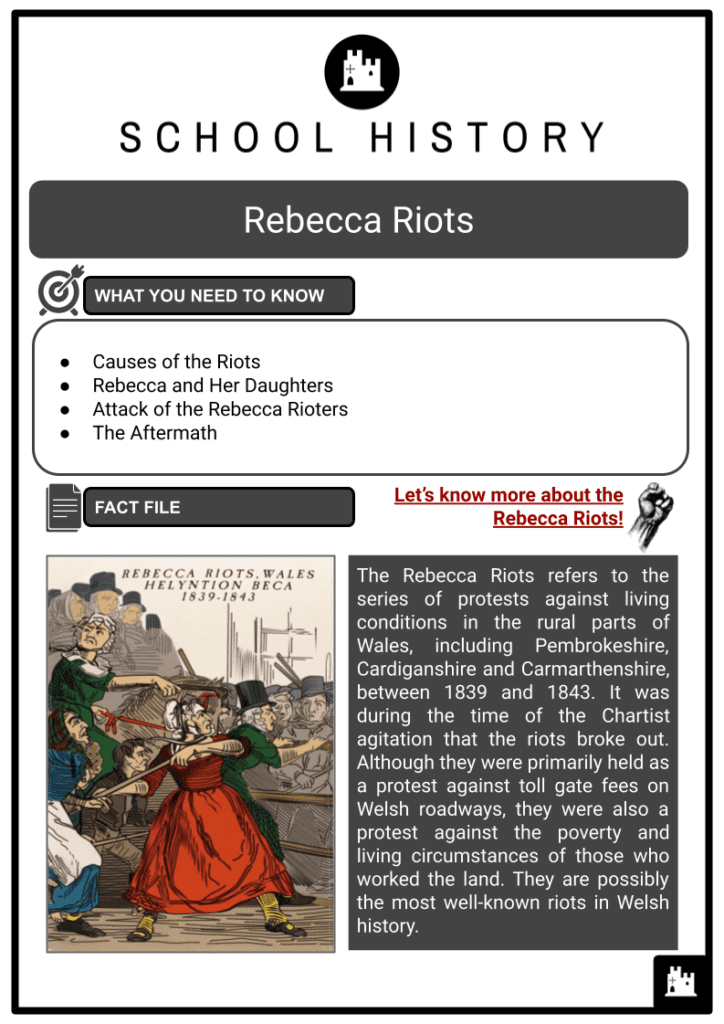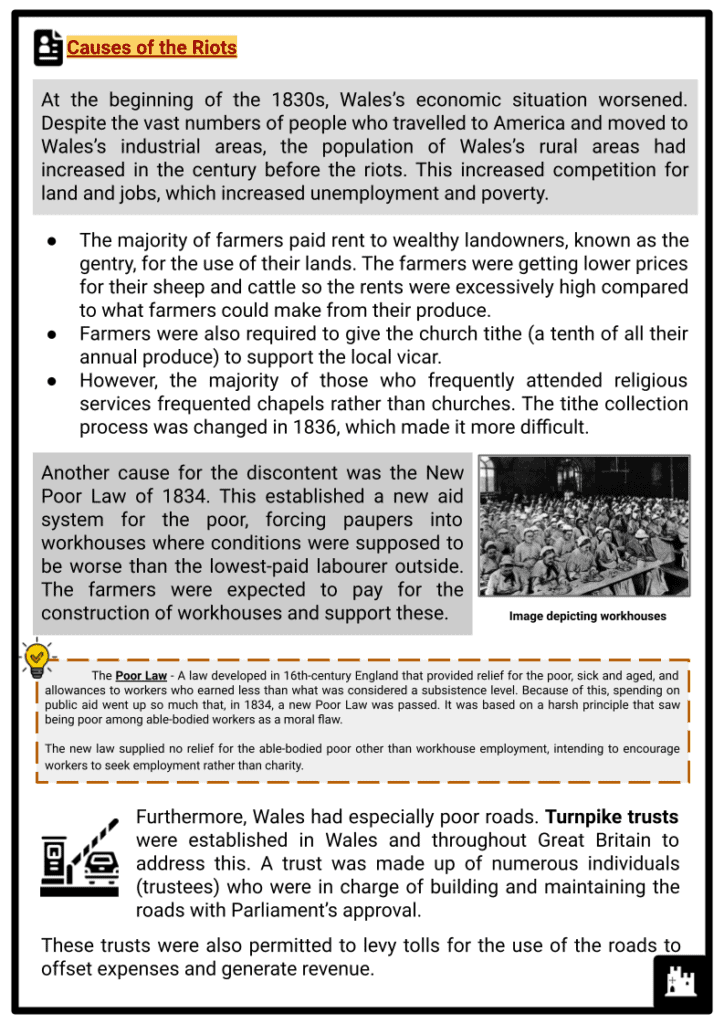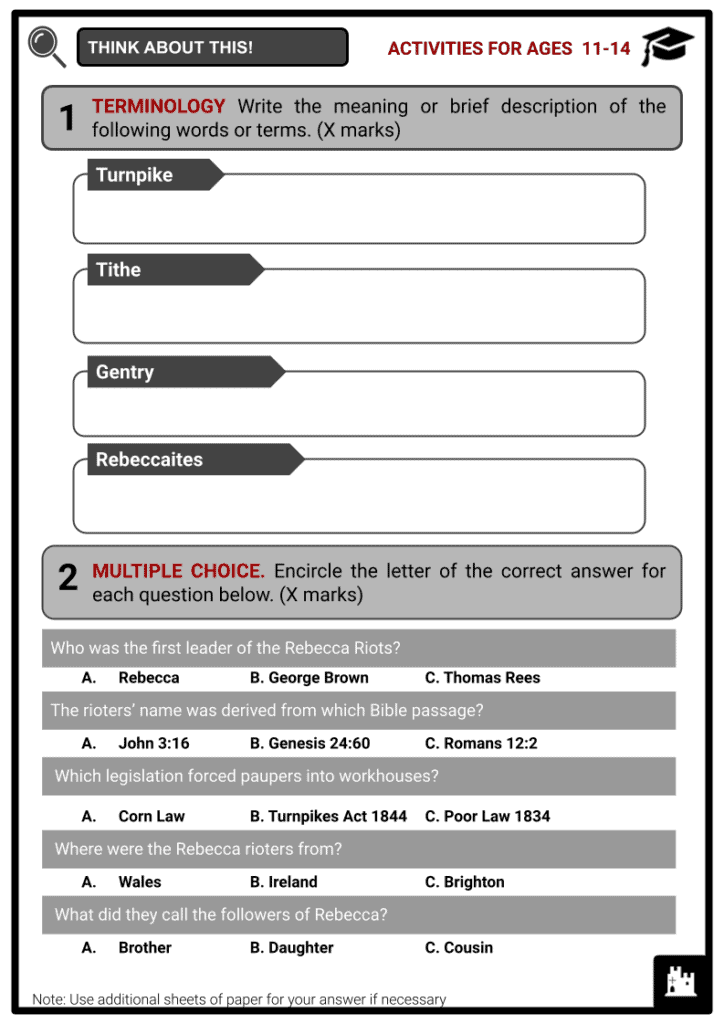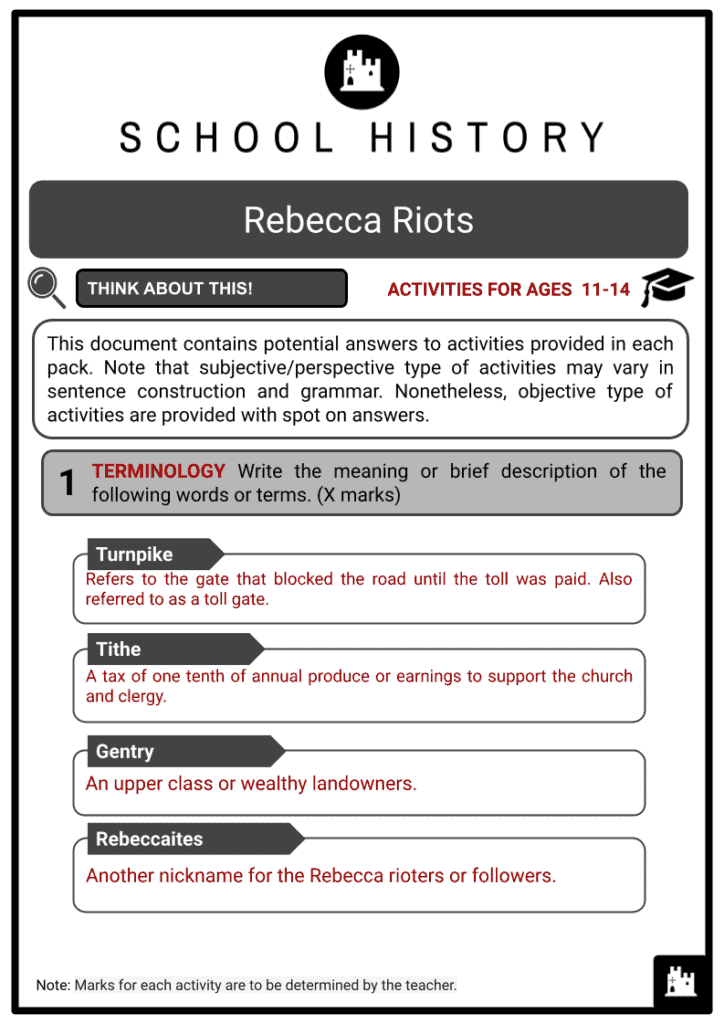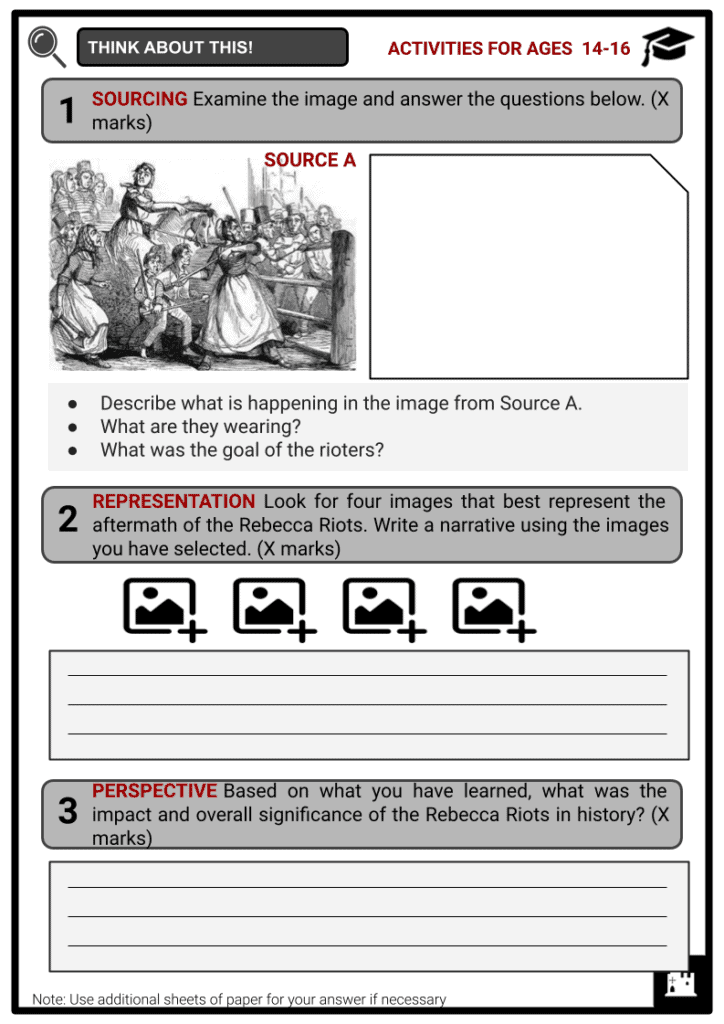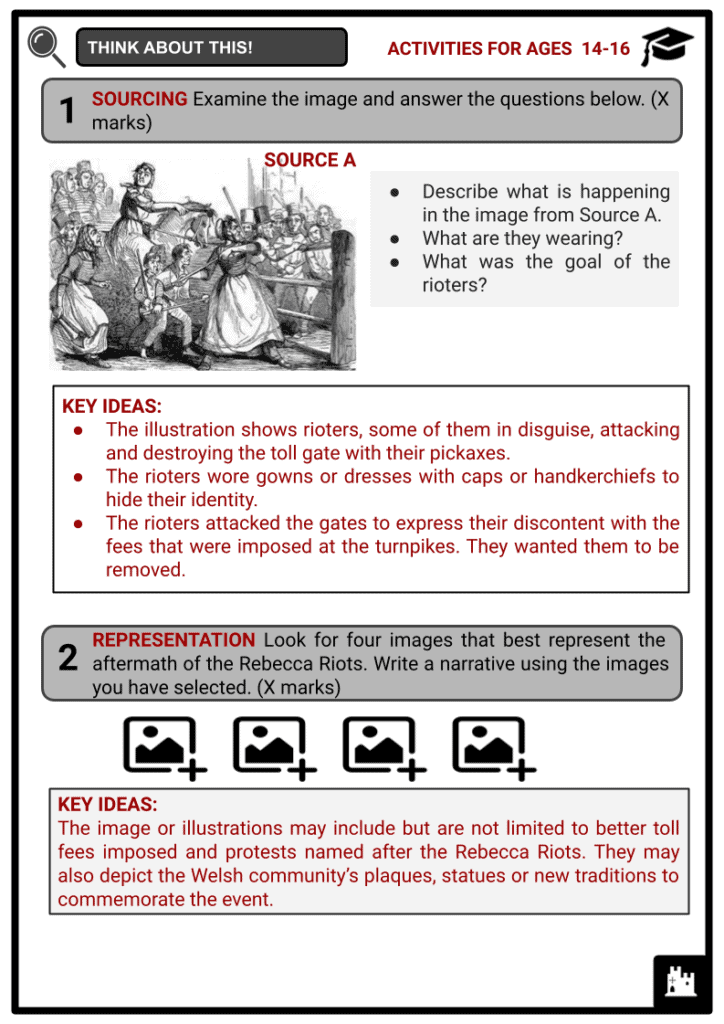Rebecca Riots Worksheets
Do you want to save dozens of hours in time? Get your evenings and weekends back? Be able to teach about the Rebecca Riots to your students?
Our worksheet bundle includes a fact file and printable worksheets and student activities. Perfect for both the classroom and homeschooling!
Summary
- Causes of the Riots
- Rebecca and Her Daughters
- Attack of the Rebecca Rioters
- The Aftermath
Key Facts And Information
Let’s find out more about the Rebecca Riots!
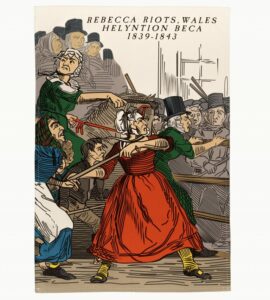
The Rebecca Riots refers to the series of protests against living conditions in the rural parts of Wales, including Pembrokeshire, Cardiganshire and Carmarthenshire, between 1839 and 1843. It was during the time of the Chartist agitation that the riots broke out. Although they were primarily held as a protest against toll gate fees on Welsh roadways, they were also a protest against the poverty and living circumstances of those who worked the land. They are possibly the most well-known riots in Welsh history.
Causes of the Riots
- At the beginning of the 1830s, Wales’s economic situation worsened. Despite the vast numbers of people who travelled to America and moved to Wales’s industrial areas, the population of Wales’s rural areas had increased in the century before the riots. This increased competition for land and jobs, which increased unemployment and poverty.
- The majority of farmers paid rent to wealthy landowners, known as the gentry, for the use of their lands. The farmers were getting lower prices for their sheep and cattle, so the rents were excessively high compared to what farmers could make from their produce.
- Farmers were also required to give the church tithe (a tenth of all their annual produce) to support the local vicar.
- However, the majority of those who frequently attended religious services frequented chapels rather than churches. The tithe collection process was changed in 1836, which made it more difficult.
- Another cause for the discontent was the New Poor Law of 1834. This established a new aid system for the poor, forcing paupers into workhouses where conditions were supposed to be worse than the lowest-paid labourer outside. The farmers were expected to pay for the construction of workhouses and support these.
- The Poor Law - A law developed in 16th-century England that provided relief for the poor, sick and aged and allowances to workers who earned less than what was considered a subsistence level. Because of this, spending on public aid went up so much that, in 1834, a new Poor Law was passed. It was based on a harsh principle that saw being poor among able-bodied workers as a moral flaw. The new law supplied no relief for the able-bodied poor other than workhouse employment, intending to encourage workers to seek employment rather than charity.
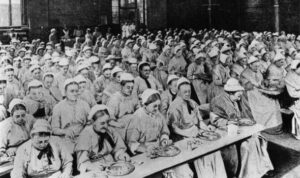
Image depicting workhouses - Furthermore, Wales had especially poor roads. Turnpike trusts were established in Wales and throughout Great Britain to address this. A trust was made up of numerous individuals (trustees) who were in charge of building and maintaining the roads with Parliament’s approval. These trusts were also permitted to levy tolls for the use of the roads to offset expenses and generate revenue.
- In addition to using the roads to transport their livestock and produce to market, farmers also used them to collect lime. The toll gate system was the trigger for the riots. For small farmers, toll fees were a significant expense.
- Farmers were particularly heavily hit and had to pay an increasing amount of these tolls in order to transport their goods, even over short distances. For instance, at least eleven separate turnpikes were encircling Carmarthen, a significant market town. The farmers already small income was diminished by the additional financial burden.
- A new gate was built at Efailwen in 1839 to prevent farmers from avoiding tolls. It was the final straw. There were already too many toll gates and the crowd destroyed the Efailwen gate. Once it was rebuilt, it was destroyed again.
Rebecca and Her Daughters
- The name of the rioters was derived from a Bible passage in the Book of Genesis that says: ‘And they blessed Rebekah, and said unto her, Thou art our sister, by thou the mother of thousands of millions and let thy seed possess the gate of those that hate them.’ (Genesis 24:60).
- The leaders were called ‘Rebecca’, and his followers were referred to as ‘daughters’. The rioters frequently dressed as women and blackened their faces or wore masks for disguise.
- The Rebeccaites frequently added other bizarre details to their darkened faces. The ultimate goal was less about disguise and more about the symbolic role that the activists took on through their costumes and frequently ritualised, theatrical attacks.
- According to other accounts, the rioters borrowed women’s clothing from a woman named Rebecca who lived near the base of the Preseli Hills. It was said that this woman was an old maid whose garments were borrowed since she was the only tall and huge woman in the village.
- The rioters became known as Merched Beca (Welsh for ‘Rebecca’s Daughters’) or merely ‘the Rebeccas’.
Attack of the Rebecca Rioters
- The Rebecca Riots were a reaction not only to the toll gates, but also to other things that made life hard for Welsh farmers. The toll gates were chosen because they were the most visible part of the system that the rioters hated so much.
- Since the Poor Law and toll roads were both disliked, the only other choice would have been the union workhouses. However, these were easy to defend and were often guarded by troops.
- In 1839, the first Rebecca Riots were led by Thomas Rees, also known as Twm Carnabwth. Nobody knows who called the meeting or showed up at the Glynsaithmaen property in the Preseli highlands.
- However, the 33-year-old redhead Thomas Rees was chosen to lead the attack in Carmarthenshire when a new toll gate at Efailwen was destroyed and set on fire. This gate, located on the road used by farmers transporting lime back from the seaside, was an obvious target. The Whitland Turnpike Trust repaired the gate, only to have it damaged once more in June.
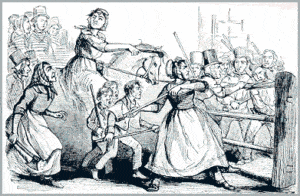
Image depicting the attack at the toll gate - On multiple occasions, Anglican clerics from the established Church of England were targeted. The Church of England was able to demand tithes and other ecclesiastical advantages, despite the fact that the majority of Welsh citizens were nonconformists. To address complaints about tithes, rent, the poor law, and other issues, large gatherings were convened.
- At Llanboidy, a second new toll gate was attacked. The authorities decided that the gates would not be constructed, and as a result the commotion subsided.
- In 1842, the disturbances resumed when the Whitland Trust constructed a new gate at The Mermaid on the lime road in St Clears, Carmarthenshire, which angered the locals. It was destroyed in November by the Rebeccas together with the other toll gates such as Pwll-trap and Trevaughan.
- The magistrates requested the Pembroke Dock marines and the Castlemartin Yeomanry Cavalry after the government declined to send soldiers, but the rioting continued.
- In July 1843, representatives of the Rebeccas sent letters to landlords of farmers, indicating a move away from the focus on toll gates and towards more widespread grievances against the landlord class. These threatening letters served as a reminder to the landlords to lower the rent they were charging their tenant farmers.
- On 6 July 1843, a witness, John Jones, passed the Bolgoed turnpike gate located on the route between Swansea and Pontarddulais, Wales. He claimed to have witnessed hundreds of men destroying the gate. They used pickaxes to demolish the toll house, and saws to hack the gate down. According to the witness’s later court testimony, what struck him as odd was that the men had disguised themselves.
- They had donned white shirts and women’s nightgowns and head gear. He also mentioned a man on horseback and that the crowd had addressed him as ‘Mother’.
- Llanelli, a market town in Carmarthenshire, was not spared from the rioters’ rage. In the summer of 1843, the Sandy, Furnace and Tyrfran Gates were destroyed.
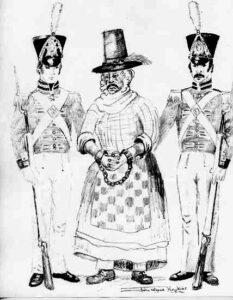
A rioter apprehended by the soldiers - During the riots of the Rebeccas, at least one person was killed. Despite being informed that a disturbance was coming, one toll gate keeper remained. On 7 September 1843, a young woman named Sarah Williams was killed in the small village of Hendy.
- The British dispatched troops to assist with local law enforcement. The government sent veteran Major General George Brown. He dispersed police and military units in strategic locations throughout the three affected counties.
- Due to the increased soldier presence, the farmers believed that it would be best to avoid violent protests, so local and open protest meetings began to replace riots.
- In the summer of 1843, this strategy yielded effects as the number of riots decreased.
- Eventually, the Rebecca Riots were suppressed. A few rioters were apprehended and were deported to Australia.
The Aftermath
- In the end, the government reformed the Poor Law and the toll gate system to remove some of their worst components, and the economy gradually improved. More people shifted from rural to urban areas.
- The name ‘Rebecca’ stayed. Locals in mid-Wales used the name in their protests in the 1860s and 1870s to oppose the selling of fishing rights to outside parties, and farmers have used it in their recent protests against agricultural policy.
- In the 1990s, the locals in Porthmadog acquired the right to impose tolls at a still-operating toll, which they called Rebecca, and donated the revenue to local charities.
- In 1844, the Turnpikes (South Wales) Act was passed. This act strengthened the trusts, streamlined the rates and halved the transportation fee for lime.
- The Rebecca Riots influenced subsequent Welsh demonstrations. In the 1860s and 1870s, opposition against the privatisation of salmon reserves on the River Wye became known as ‘the Second Rebecca Riots’.

